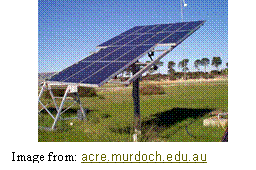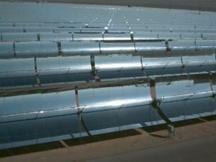The information on this page was prepared by:
| Garrett Cano | gcano@usc.edu | Industrial and Systems Engineering |
Solar
Solar energy is perhaps one of the cleanest sources of energy. There are no emissions and is safe. More importantly, there is a lot of energy. In 20 minutes, the sun releases enough energy on the United States to provide the nation’s total energy for one year. However, the reason solar energy is not the main source of energy is because it is not efficient enough. It is difficult to capture the sun’s energy. A good amount of space is required for solar cells and the solar cells are expensive. In addition to this, solar energy is dependent upon the weather. Although solar energy only accounts for .02 percent of the United States’s energy supply, and 1% of the total renewable energy, solar technology has many advances to be made.
 The primary method of turning solar energy into electricity is through the use of solar cells, also called photovoltaic cells. The photovoltaic process converts sunlight into electricity. These cells are composed of semiconductors usually made from silicon. Sunlight is composed of photons. Depending on the wavelength of the sun’s rays, a different amount of energy is contained in the photons. When the photons enter the photovoltaic cell, the photons are either reflected or absorbed. The absorbed photons are converted into electricity. The photons hit the material and dislodge electrons from the cell. When this happens, a hole is created. This hole allows charge to change causing electrons to move to fill this hole. This creates electricity.
The primary method of turning solar energy into electricity is through the use of solar cells, also called photovoltaic cells. The photovoltaic process converts sunlight into electricity. These cells are composed of semiconductors usually made from silicon. Sunlight is composed of photons. Depending on the wavelength of the sun’s rays, a different amount of energy is contained in the photons. When the photons enter the photovoltaic cell, the photons are either reflected or absorbed. The absorbed photons are converted into electricity. The photons hit the material and dislodge electrons from the cell. When this happens, a hole is created. This hole allows charge to change causing electrons to move to fill this hole. This creates electricity.
A photovoltaic cell ranges in size from 1 cm to 10 cm across. With this small size, each cell can only produce one to two watts. Because of this, photovoltaic cells are combined in modules to increase the output. The cells are dependent on good weather and are only 10 % efficient, meaning they only capture 10% of the sunlight’s energy.
The Future of Solar Energy
As mentioned, the problem with solar energy is it is difficult to harness its energy. A great deal of space is required for photovoltaic cells. Solar technology will soon be using nano-technology to convert sunlight into energy. Nano-technology will take up very little space. Nano Solar Cells will be able to be painted on to surfaces such as buildings or billboards. Currently, nano solar cells are only able 1/10 as efficient as photovoltaic cells, but researchers believe they will be able to make them just as efficient.
Sources:
1. http://www.whitehouse.gov/energy/
2. http://www.eia.doe.gov/kids/renewable/solar.html
3. http://www.eia.doe.gov/